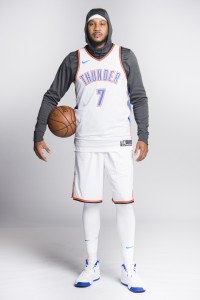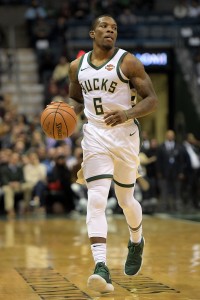Back in 2016, player option decisions were essentially mere formalities. With the NBA salary cap set to spike, nearly every veteran with a player option on his contract decided to opt out and explore the free agent market. Only three players – Tim Duncan, Mo Williams, and Caron Butler – exercised their player options that year, and none of those players have appeared in the NBA since then.
The market shifted a little in 2017, as five players picked up their player options, and several other players perhaps should have. Dante Cunningham, Rudy Gay, Aron Baynes, and Nick Young are among the players earning less this season than they would have if they’d exercised their options, and David Lee opted out of his deal only to announce his retirement a few months later.
The NBA’s salary cap continues to increase, but it’s no longer jumping at nearly the same rate it was in 2016, which means veterans holding player options for 2018 may be less inclined to explore the market — there simply aren’t as many teams willing to throw money around.
A look at the list of player options for 2018/19 reveals several options that will likely be picked up. For instance, Wesley Matthews ($18.6MM), Darrell Arthur ($7.5MM), Wesley Johnson ($6.1MM), Jason Smith ($5.5MM), and Ron Baker ($4.5MM) are unlikely to find offers on the open market that are more lucrative than their option salaries. Of course, there are also still plenty of options that will be quickly declined — the odds of Paul George exercising his $20.7MM player option are slim.
Somewhere in between those two extremes, there are several 2018/19 player option decisions that remain unclear. These players may be leaning one way or the other right now, but the decision isn’t so obvious that it should be considered a lock quite yet. Here are five of those player option decisions worth keeping an eye on this season:
 Carmelo Anthony, Thunder ($27,928,140): The Thunder’s new-look roster has been dubbed a one-year experiment, but even if things go south in Oklahoma City this season, there’s little reason not to expect two of the team’s “Big Three” players back next year. Russell Westbrook is on a long-term extension, and Anthony’s $27.9MM option is probably too lucrative to pass up, considering he’s 33 years old and is seeing his production decline. If the season goes really poorly for the Thunder, maybe Anthony opts out just to get a change of scenery, but at this point, I’d count on him opting in.
Carmelo Anthony, Thunder ($27,928,140): The Thunder’s new-look roster has been dubbed a one-year experiment, but even if things go south in Oklahoma City this season, there’s little reason not to expect two of the team’s “Big Three” players back next year. Russell Westbrook is on a long-term extension, and Anthony’s $27.9MM option is probably too lucrative to pass up, considering he’s 33 years old and is seeing his production decline. If the season goes really poorly for the Thunder, maybe Anthony opts out just to get a change of scenery, but at this point, I’d count on him opting in.- Jeremy Lin, Nets ($12,516,746): After an injury-plagued 2016/17 season in which he appeared in just 36 contests, Lin had high hopes for the 2017/18 campaign. However, he didn’t even make it through a single game this year, rupturing his patellar tendon in the Nets’ opener. When Lin is healthy, he’s a dynamic point guard who could command a solid long-term deal. But he’ll be 30 next summer and will be coming off a major injury. It might make sense to just play it safe and opt in for one more year in Brooklyn.
- Wilson Chandler, Nuggets ($12,800,562): Chandler has been a Nugget since 2011, making him the team’s longest-tenured player, but it has been a bumpy ride at times. Although Chandler has averaged between 30.9 and 31.7 minutes per contest in every season since 2013/14, he hasn’t always been happy with his role over the years, with a report back in February suggesting he was hoping for a trade. Chandler has struggled this season, and his three-point efficiency has been on the decline, but if he can bounce back, he’d be an appealing free agent target for teams in need of a wing with some size or a small-ball power forward. He probably wouldn’t earn more than $12.8MM per year, but he should be able to exceed that figure in terms of total salary.
- Cory Joseph, Pacers ($7,945,000): Long regarded as one of the NBA’s top backup point guards, Joseph’s numbers in Toronto and now Indiana have been fairly modest. Still, it might make sense for him to pass up an $8MM salary in search of a larger payday and perhaps a chance to earn a slightly larger role. An improved outside shot figures to make Joseph more appealing to potential suitors — in his first five NBA seasons, he made just 29.4% of his three-point attempts, but he has increased that mark to 38.5% since the start of the 2016/17 season.
- Enes Kanter, Knicks ($18,622,514): Kanter’s option decision was considered so obvious that his probable opt-in was reported back in August, with his decision deadline still 10 months away. Has his strong play in New York changed that? Probably not. Despite averaging a double-double with 13.8 PPG and 10.6 RPG so far, Kanter remains an average defender at best, and big men who don’t either protect the rim or shoot three-pointers have limited upside in free agency. Although the future for Kanter looks brighter than it did a few months ago, it’s still hard to imagine him turning down an $18.6MM salary for next season.
Photo courtesy of USA Today Sports Images.
